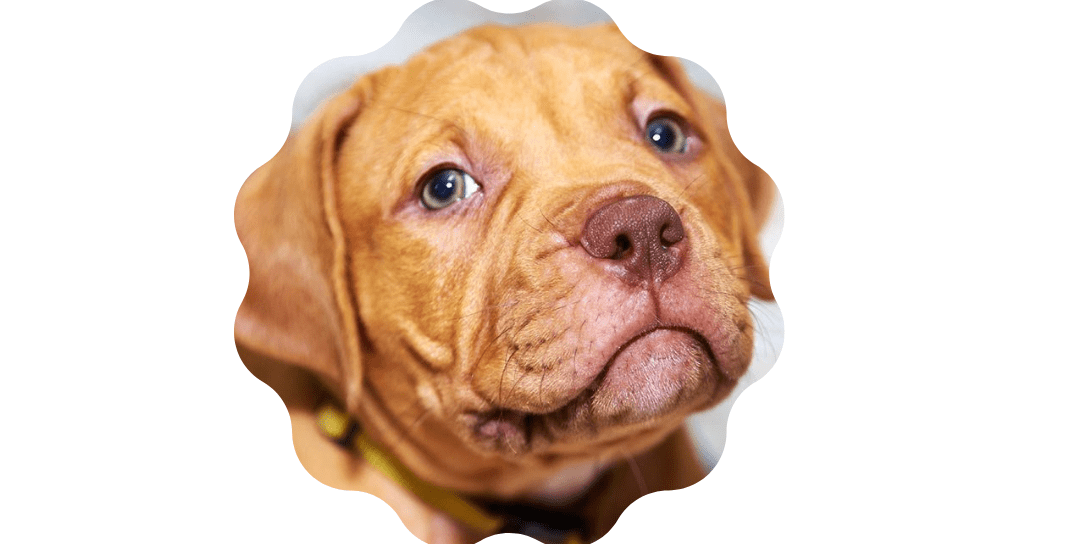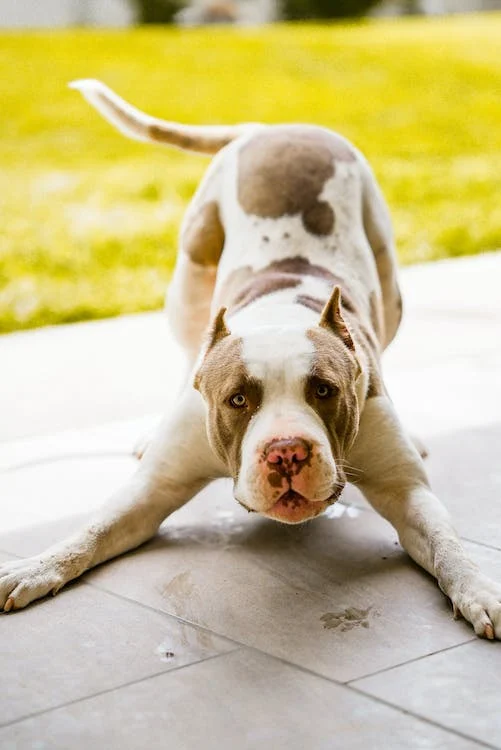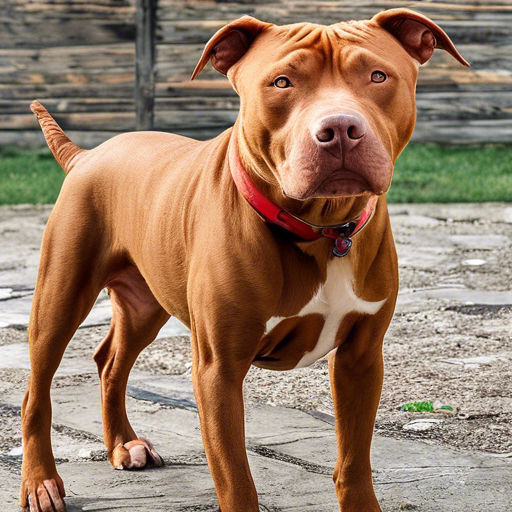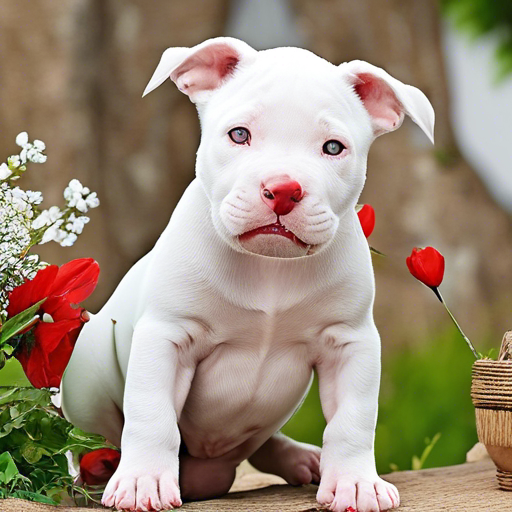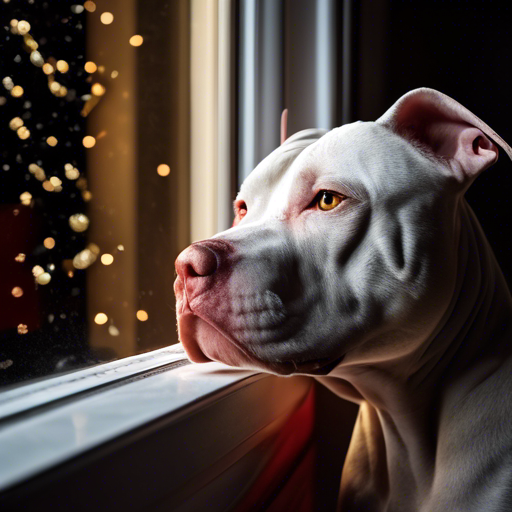history of the Old Family Red Nose Pitbull- 2024
The Old Family Red Nose Pitbull, often simply referred to as the Red Nose Pit Bull, is a historic lineage within the larger American Pit Bull Terrier breed. This particular line is renowned for its distinctive red-colored nose and coat, along with its temperament and physical characteristics.
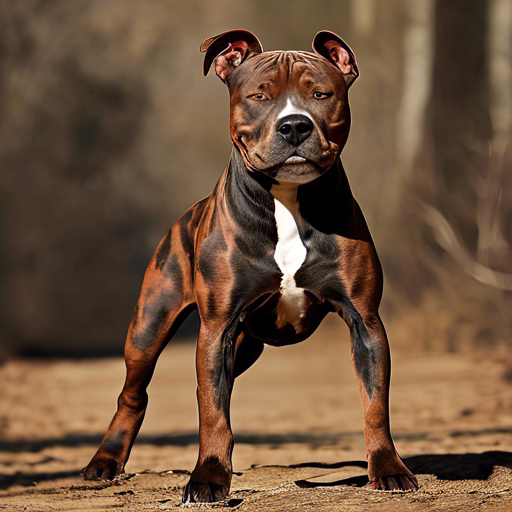
The history of the Old Family Red Nose Pitbull traces back to the early 19th century in Ireland and England. These dogs were originally breed for various tasks, including bull-baiting, bear-baiting, and later, as catch dogs for controlling livestock and hunting. The term “Old Family” denotes a specific family line or strain of the breed, known for its consistency in producing dogs with certain desired traits.
The Red Nose Pit Bull’s ancestry can be traced to the dogs brought by Irish and English immigrants to America during the 19th century. These immigrants often brought their working dogs with them, which eventually contributed to the development of the American Pit Bull Terrier breed. The Old Family Red Nose line emerged from these early American breeding efforts, with a focus on preserving and enhancing specific traits, including intelligence, loyalty, agility, and gameness.
Throughout the years, the Old Family Red Nose Pit Bulls gained a reputation for their loyalty and affection towards their owners, as well as their willingness to work and their remarkable athleticism. However, it’s essential to note that responsible breeding practices are crucial to maintain the breed’s temperament and health.
Despite their historical significance and popularity among enthusiasts, the Old Family Red Nose Pit Bulls, like all Pit Bull breeds, have faced controversy due to misconceptions and negative portrayals in the media. Breed-specific legislation and stigmatization have led to challenges for responsible owners and breeders in preserving and promoting these dogs.
Today, the Old Family Red Nose Pit Bull continues to be cherished by enthusiasts who appreciate its rich history, distinctive appearance, and versatile abilities. Through responsible breeding and advocacy, efforts are made to ensure that these dogs are recognized for their positive traits and contributions as loyal companions and working dogs.
Characteristics of Old Family Red Nose Pitbull- free Learn
The Old Family Red Nose Pitbull, often referred to simply as the Red Nose Pit Bull, is a specific bloodline within the larger Pit Bull breed. Here are some characteristics commonly associated with the Old Family Red Nose Pit Bull:
Appearance:
- The Red Nose Pit Bull typically has a red or copper-colored nose, which is where it gets its name. Their coat can vary in color, but they often have a solid coat with shades of red, brown, or fawn. They have a muscular, athletic build and a strong jaw.
Temperament:
- Known for their loyalty and affection towards their owners, Red Nose Pit Bulls are often described as gentle and loving companions. With proper training and socialization, they can be great family pets. They are also known for their high intelligence and eagerness to please, which makes them relatively easy to train.
Strength and Agility:
- Red Nose Pit Bulls are strong, agile dogs with a lot of energy. They require regular exercise and mental stimulation to keep them happy and healthy. They excel in activities like agility training, obedience competitions, and even weight pulling.
Socialization:
- Early socialization is crucial for Red Nose Pit Bulls to ensure they are well-adjusted and comfortable around other animals and people. Proper training and socialization can help prevent any potential aggression, although individual temperament can vary.
Health:
- Like all dog breeds, Red Nose Pit Bulls are prone to certain health issues, including hip dysplasia, skin allergies, and heart conditions. Responsible breeding practices and regular veterinary care can help mitigate these risks.
Protective Instincts:
- Red Nose Pit Bulls have a natural instinct to protect their family members and territory. While they are generally friendly with people when properly socialized, they can be wary of strangers and may exhibit protective behaviors.
Companionship:
- Despite their sometimes intimidating appearance, Red Nose Pit Bulls are affectionate and loyal companions. They thrive on human interaction and form strong bonds with their owners, often seeking out physical affection and attention.
Historical Significance:
- The Old Family Red Nose Pit Bull bloodline has a rich history, with roots tracing back to the 19th century. They were originally bred for bull-baiting and later as farm dogs. Today, they are valued as loyal family pets and working dogs in various roles, including therapy work and search and rescue.
It’s important to note that while these characteristics are commonly associated with the Old Family Red Nose Pit Bull, individual dogs may vary in temperament and behavior based on factors such as upbringing, training, and genetics. Responsible ownership, including proper training, socialization, and providing a loving environment, is key to ensuring that any dog, including a Red Nose Pit Bull, becomes a well-behaved and balanced companion.
Evolution of Old Family Red Nose Pitbull
The Old Family Red Nose Pitbull, also known simply as the Red Nose Pit Bull, has a fascinating evolutionary history that traces back to the early 19th century. Here’s an overview of the evolution of this distinctive breed:
Origins:
- The roots of the Old Family Red Nose Pit Bull can be traced back to Ireland and England in the early 1800s. These dogs were originally bred for various purposes, including bull-baiting, a cruel sport where dogs were pitted against bulls in a ring.
Bull and Terrier Breeds:
- During this time, breeders sought to create dogs with the strength, agility, and tenacity to excel in bull-baiting and other blood sports. They crossed various breeds, including Bulldogs and Terriers, to produce animals that possessed the desired traits for these activities.
Transition to Pit Bulls:
- As bull-baiting and other blood sports became illegal in the 19th century, the focus shifted to dog fighting. Breeders continued to refine their stock, producing dogs specifically tailored for the pit, hence the name “Pit Bull.”
Development of the Red Nose Strain:
- Within the broader category of Pit Bulls, certain bloodlines began to emerge with distinctive physical and temperamental characteristics. The Red Nose Pit Bull is one such lineage, known for its distinctive red or copper-colored nose.
Selective Breeding:
- Over generations, breeders selectively bred dogs with desirable traits, including the signature red nose, muscular build, and loyal temperament. The Old Family Red Nose Pit Bull became known for its prowess in the pit as well as its loyalty and affection toward its owners.
Diverse Roles:
- While the Red Nose Pit Bull was originally bred for fighting and hunting, its versatility led to it being utilized in various roles, including as farm dogs, guardians, and companions. Despite its history in blood sports, responsible breeders and owners have worked to promote the breed’s positive attributes and discourage involvement in illegal activities.
Modern Times:
- Today, the Old Family Red Nose Pit Bull continues to be valued for its loyalty, intelligence, and affectionate nature. While it retains its athleticism and strength, efforts are ongoing to promote responsible ownership and combat negative stereotypes associated with the breed.
Throughout its evolution, the Old Family Red Nose Pit Bull has adapted to changing societal norms and roles while retaining its core traits. Despite its challenging history, responsible breeding and ownership have helped shape the Red Nose Pit Bull into a beloved companion and working dog.
Training Of Old Family Red Nose Pitbull
Training an Old Family Red Nose Pit Bull, like any other dog, requires patience, consistency, and positive reinforcement techniques. Here are some tips for effectively training your Red Nose Pit Bull:
Start Early:
- Begin training your Red Nose Pit Bull as soon as you bring them home, ideally when they are still a puppy. Early socialization and obedience training are crucial for shaping their behavior and temperament.
Use Positive Reinforcement:
- Positive reinforcement techniques, such as praise, treats, and rewards, work best with Red Nose Pit Bulls. Use these to encourage good behavior and to reinforce desired actions during training sessions.
Be Consistent:
- Consistency is key when training a Red Nose Pit Bull. Establish clear rules and boundaries, and ensure that everyone in the household follows them consistently. Inconsistency can lead to confusion and hinder progress in training.
Focus on Basic Commands:
- Start with basic obedience commands like “sit,” “stay,” “come,” and “down.” These commands form the foundation for more advanced training and help establish you as the leader in your dog’s eyes.
Keep Training Sessions Short and Fun:
- Red Nose Pit Bulls have a lot of energy, so keep training sessions short (about 10-15 minutes) to prevent boredom and maintain their focus. Make training sessions fun and engaging by incorporating games and interactive activities.
Provide Mental Stimulation:
- In addition to physical exercise, Red Nose Pit Bulls need mental stimulation to prevent boredom and destructive behavior. Use puzzle toys, obedience exercises, and interactive games to keep their minds engaged.
Socialize Your Dog:
- Introduce your Red Nose Pit Bull to different people, animals, and environments from a young age to help them become well-adjusted and confident. Proper socialization can prevent fearfulness and aggression later in life.
Be Patient and Persistent:
- Training a Red Nose Pitbull takes time and patience. Don’t get discouraged by setbacks or slow progress. Stay consistent, remain patient, and celebrate small victories along the way.
Seek Professional Help if Needed:
- If you encounter difficulties or behavioral issues that you’re unable to address on your own, consider seeking help from a professional dog trainer or behaviorist who has experience working with Pit Bulls.
Build a Strong Bond:
- Finally, focus on building a strong bond of trust and respect with your Red Nose Pit Bull. Positive training methods, regular exercise, and plenty of love and attention will help strengthen your relationship and create a well-behaved and happy companion.
By following these training tips and techniques, you can help your Old Family Red Nose Pit Bull become a well-behaved, obedient, and cherished member of your family.
Rise in Popularity of Old Family Red Nose Pitbull
The rise in popularity of the Old Family Red Nose Pit Bull, often simply referred to as the Red Nose Pit Bull, can be attributed to several factors:
Historical Significance:
- The Old Family Red Nose Pit Bull has a rich history and lineage dating back to the 19th century. This historical significance, coupled with its reputation for loyalty and athleticism, has contributed to its enduring popularity among dog enthusiasts.
Positive Traits:
- Red Nose Pit Bulls are known for their affectionate nature, loyalty to their owners, and intelligence. These positive traits make them appealing companions for individuals and families seeking a devoted and trainable pet.
Versatility:
Despite their history in dogfighting, responsible breeders and owners have promoted the Red Nose Pit Bull’s versatility in various roles, including therapy work, search and rescue, and even service dog tasks. Their adaptability and willingness to work have expanded their appeal to a wider audience.
Media Representation:
- While media portrayals of Pit Bulls have often been negative, there has been a shift in recent years toward more positive representations. Stories of heroic Pit Bulls, successful rehabilitation efforts, and advocacy campaigns have helped improve the breed’s public image and contributed to its popularity.
Social Media Influence:
- The rise of social media platforms has provided a platform for Pit Bull advocates to share positive stories, educational content, and advocacy efforts. This online presence has helped raise awareness about the breed’s positive attributes and contributed to its increasing popularity.
Celebrity Endorsement:
- Some celebrities and influencers have publicly owned and advocated for Pit Bulls, including the Red Nose variety. Their endorsements and promotion of responsible ownership practices have further boosted the breed’s popularity and helped challenge stereotypes.
Community Involvement:
- Pit Bull advocacy groups and community organizations have played a significant role in promoting responsible ownership, providing resources for owners, and advocating for breed-specific legislation reform. Their efforts have helped foster a supportive community of Pit Bull enthusiasts and contributed to the breed’s rising popularity.
Overall, the rise in popularity of the Old Family Red Nose Pit Bull can be attributed to a combination of factors, including its positive traits, historical significance, improved media representation, and advocacy efforts by dedicated enthusiasts and organizations. Despite challenges and misconceptions, the breed continues to gain recognition and appreciation for its loyal and loving nature.
